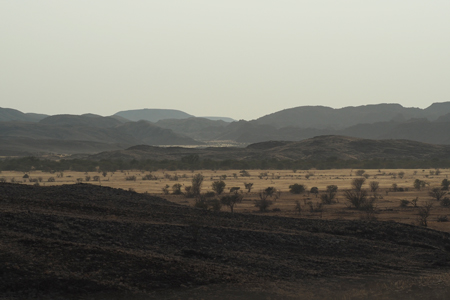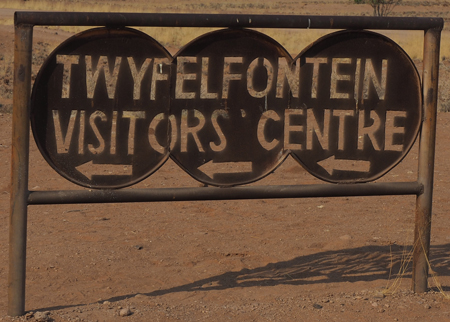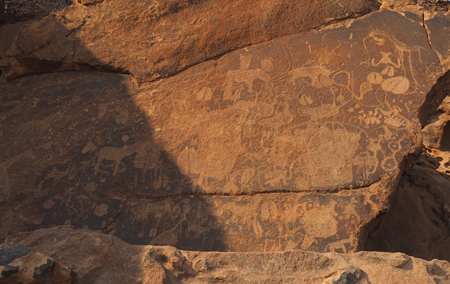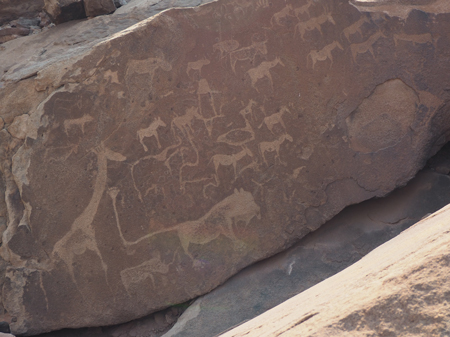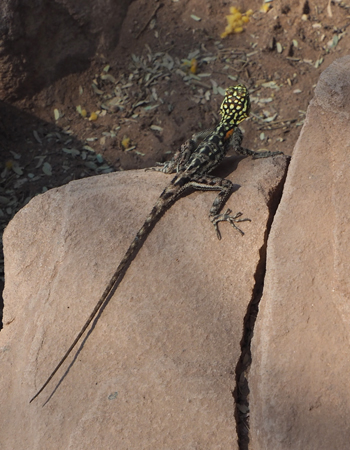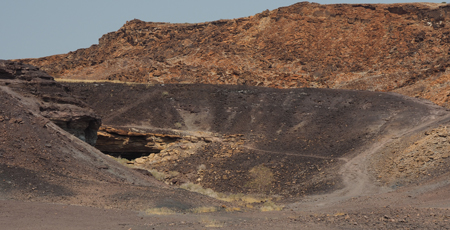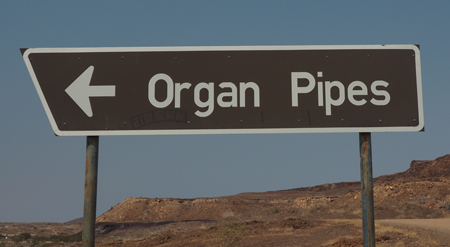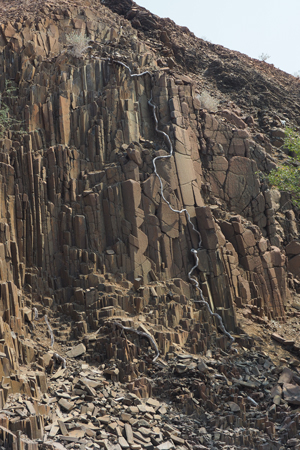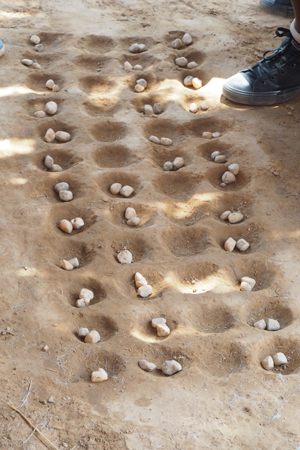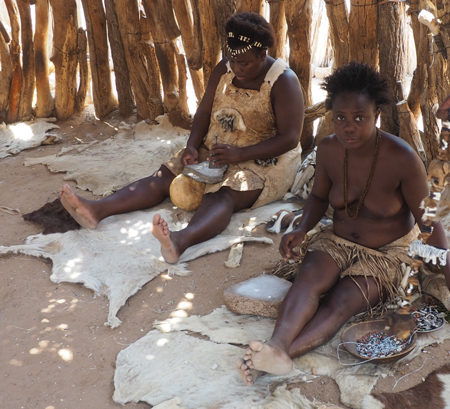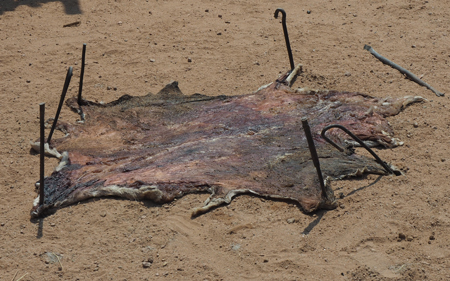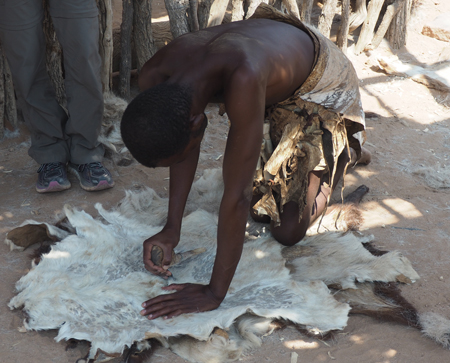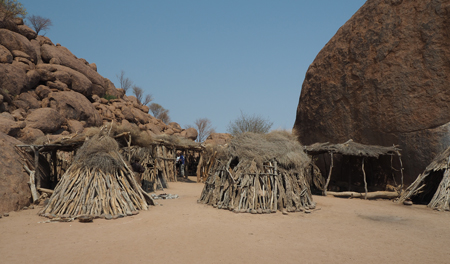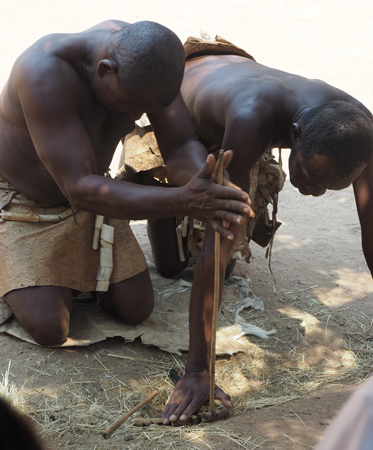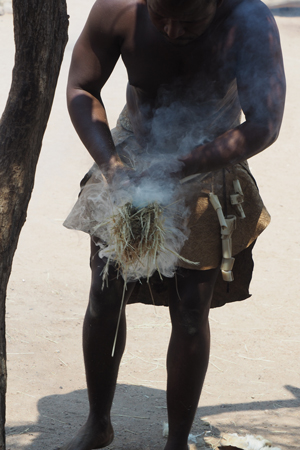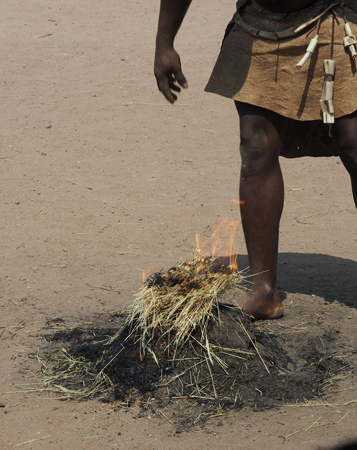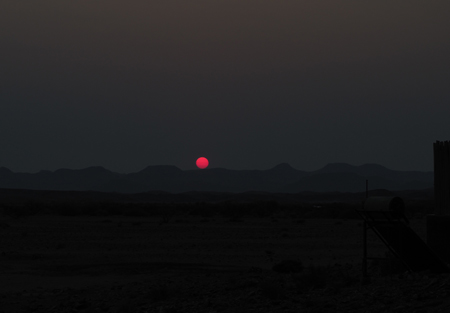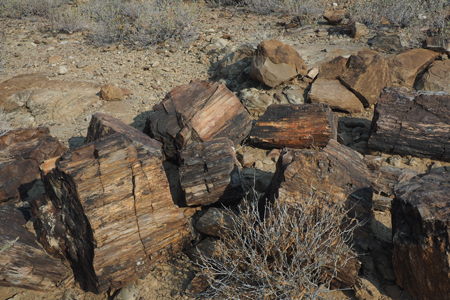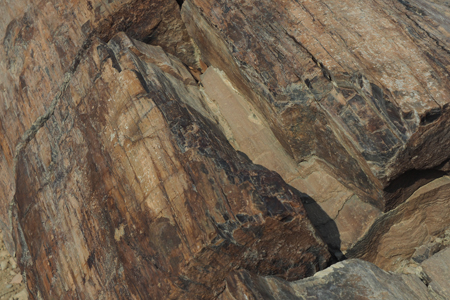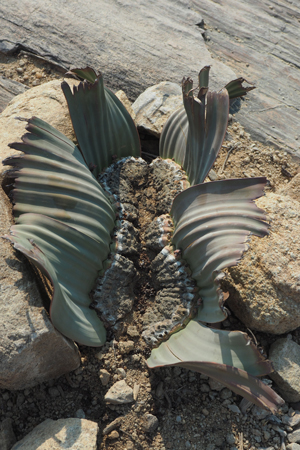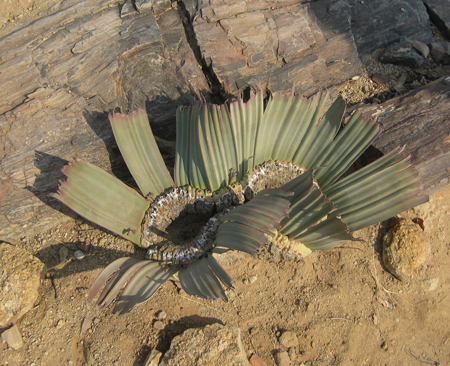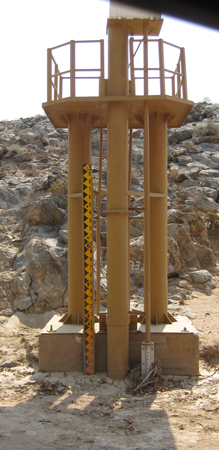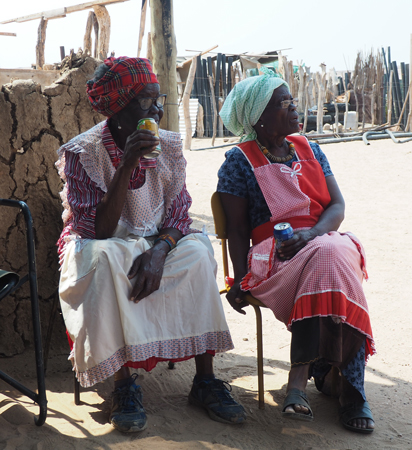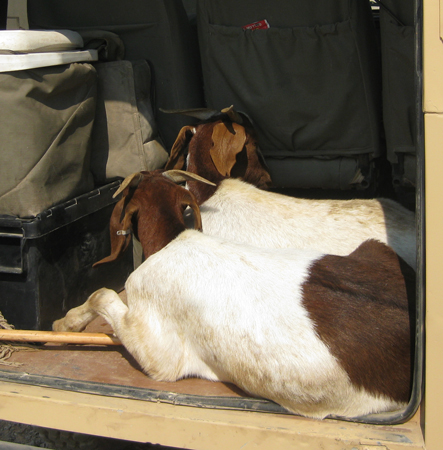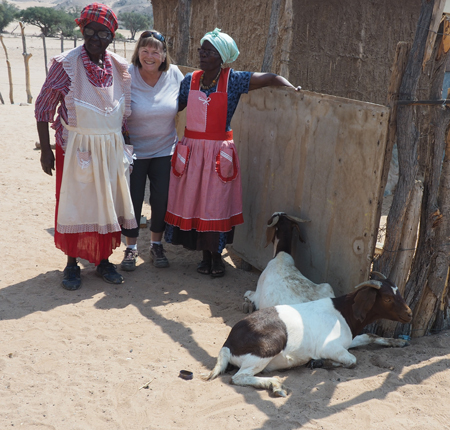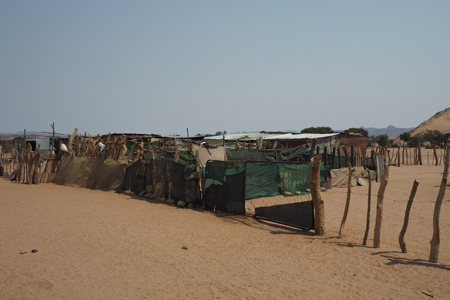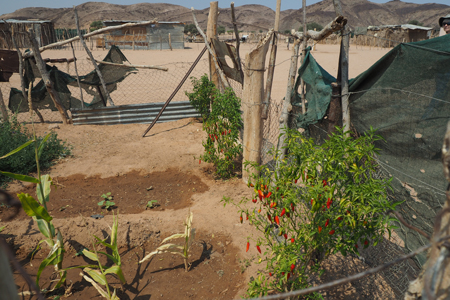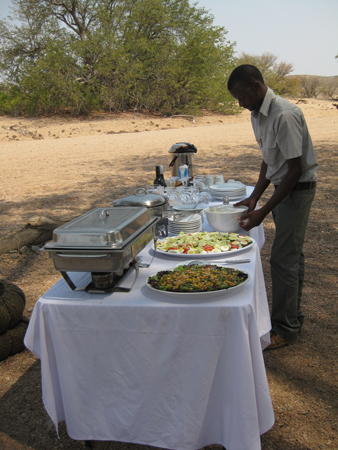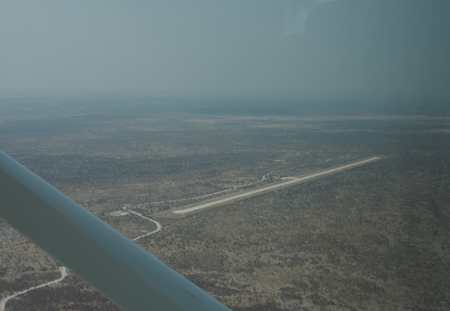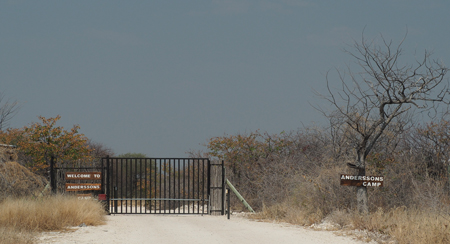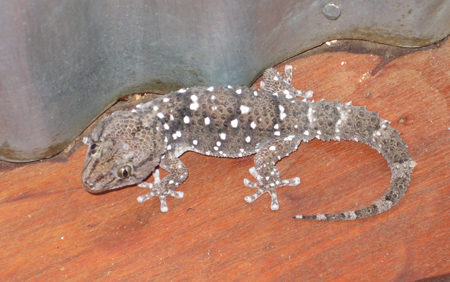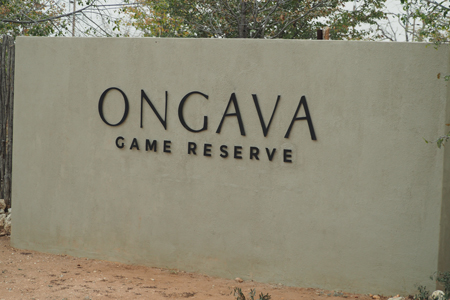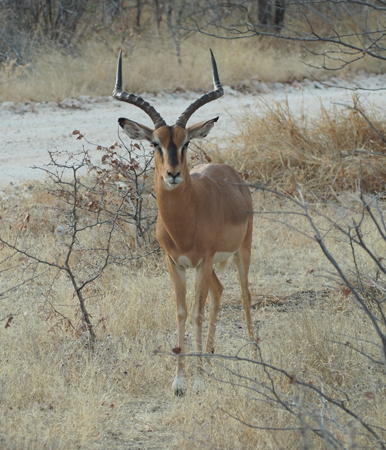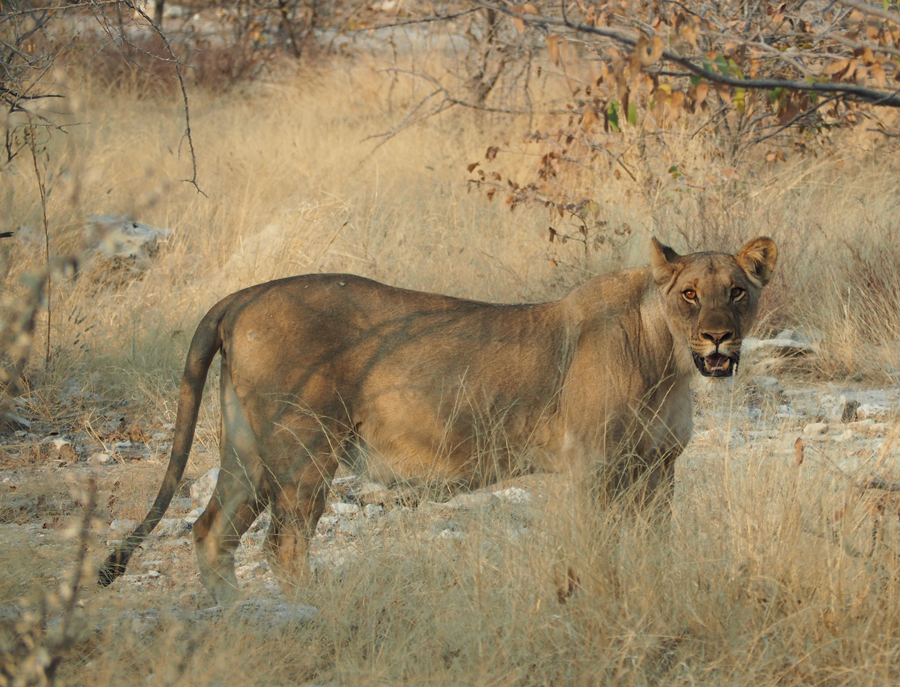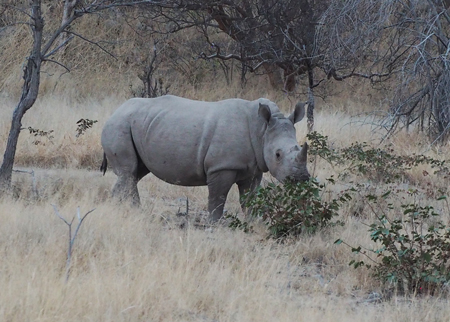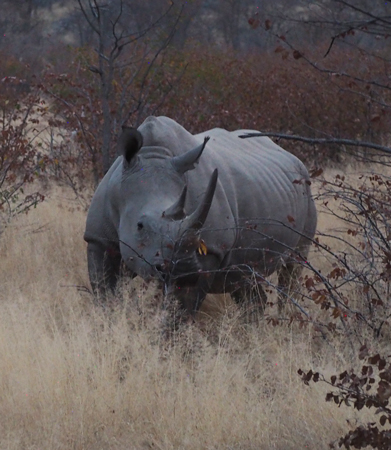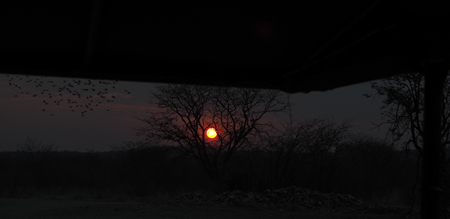Thurs., 8/31/2017 – Damaraland
We had to be up early this morning. Breakfast was at 6 and we were in the vehicles by 6:30. The idea is to get somewhere before it gets too hot. We drove for two hours to get to see the San people’s petroglyphs.
The petroglyphs at Twyfelfontein were really interesting. The word means “doubtful spring.”
Two-thousand to 6,000 years ago the San people carved petroglyphs into the sandstone rocks using quartz or basalt stones. Some of the rocks were like blackboards teaching kids the tracks of different animals so they could learn which animals to follow and which to run away from. There were many pictures of giraffes because they thought their heads were in the clouds so they would bring rain and their spots looked like rain drops. A print of a right foot was used like a signature of the carver. There were outlines of penguins, flamingoes, and seals because the bushmen traveled to the Atlantic to bring back salt. The “Lion-Man” picture is a highlight of the area. The tail of the lion ends in a human hand and an antelope is in its mouth. This symbolizes how a man becomes a lion.
The Land
Petroglyphs
Petroglyphs
Petroglyphs
Petroglyphs - Lion-man drawing
Petroglyphs
Lizard at Twyfelfontein
We drove to Burnt Mountain, which is a place of contact metamorphosis. The hot molten magna below cooked the rock above so the area looks like a black slag heap.
Next we walked among the “organ pipes” of vertical quadrangular rock. The up-flow of molten magna crated these unique forms.
Burnt Mountain
Organ Pipe formation
Organ Pipe formation
Next stop was a visit to the Living Museum of the Damara people. They make some money by showing how they live. The women wear goatskins but many don’t cover their breasts. They speak a language with four click sounds. A chief has five wives or more to ensure a son to become the next chief. All other men have only one wife. A grandmother showed us several leaves and herbs used as tribal medicines. The nearest health clinic is 70 km away. We smelled and were offered a taste of their beer. It is made from ant grass, honey, and water. Lloyd and our guide played a tribal game of stones in pocket holes in the ground. We saw how they prepare a goatskin to make cloth to wear and how they make buttons and beads for jewelry from seeds, ostrich egg shells, and porcupine quills. They showed us - for the fourth time on this trip – how to start a fire and they sang and danced for us.
Our Damara guide
Damara Living Museum - game of Hus
Damara Living Museum
Damara Living Museum - drying a goat skin
Damara Living Museum - preparing a dried goat skin
Damara Living Museum
Damara Living Museum - fire making
Damara Living Museum - fire making
Damara Living Museum - fire making - success!
Damara Living Museum - dancing
Sunset
Fri., 9/1/2017 – Damaraland
At 7 AM we left to go see Namibia’s Petrified Forest.
Two hundred and eighty million years ago, there were tall wide pine trees in this area of Africa. The pine wood cells were replaced by minerals to form the petrified wood. During the transformation the tree trunks were buried under 1,000 meters of soil and have worked their way to the surface. We walked a path to look at the petrified wood and took pictures of the national plant/flower, Welwitschia mirabilis. It is one of the oldest plants in the world. The two large leaves were all broken off by the wind. Some plants are thought to be 2,000-years-old.
Petrified Forest
Petrified Forest
Welwitschia
Welwitschia
We had tea and cookies with two elderly women at the Deriet village. Our group, acting on the idea of one of our members (Giesela), gave them two goats to add to their herd of 20. These ladies and their extended families were kicked out of South Africa 45 years ago during Apartheid. The government wanted to build a military base on their land so they “resettled” them in northern Namibia, which was then a part of South Africa called South West Africa. The land they were given had lions that preyed on their goats and cows so they moved to this desert area. There are still jackals, hyenas, and elephants to contend with. They try to grow some vegetables and food for the baby goats but it has not rained here since 2011. Their animals die in the drought and elephants destroy their gardens and fences. They now have hired a shepherd and he uses dogs to protect their animals when they go out to find grazing.
Floodwater measurements
Desert Elephant
Recipients of our Goat gift
The Goats
Recipients of our Goat gift with Gisela
Deriet village
Vegetable Garden
Lunch today was served under a huge tree in the dry riverbed. The staff carts everything out and sets up tables and a buffet.
Buffet lunch in the bush
Table set for lunch in the bush
Sat., 9/2/2017 – Damaraland to Etosha and our last camp
We had nothing scheduled before our 12-noon flight to Ongava, which is outside the Andersson’s Gate of Etosha National Park. We had a nice leisurely breakfast, packed, read, went for a walk, and waited.
After arrival at our new camp, Andersson’s Camp, we were served lunch. There is a water hole just in front of the camp’s lounge and dining area. It provides many opportunities to watch the animals and their interactions with each other.
Andersson’s Camp is scheduled for a much needed renovation after our visit. The rooms are tiny. There is no room for anything. It is hot as Hades. We will have to stand in a metal bucket to use the shower. The sink and toilet are ancient. You can see the ground between the floorboards and the doors do not have locks - a new travel wrinkle!
Flight to Etosha
Andersson's Camp
Andersson's Camp - our tin bucket tub for showering
Andersson's Camp - cute visitor
After lunch and about ½ hour to get “organized,” we set off for an afternoon game drive in the Ongava private reserve. Our guides are allowed to go off road to get close to the animals. The jeeps used here have no sides – except for the high “doors” that are metal-framed canvas – with a high canvas top. The three rows of passenger seats (9 total) are on risers so everyone can see. We have six in each jeep so everyone has a side and full view. It is windy when driving over 35 MPH, but it is fun.
On our first drive, we first saw plains zebras and black-faced impalas that are larger then the common impala and have a black streak down their forehead to their mouth.
Then we came upon a local lion pride of two lionesses, two cubs, and one male. We watched them lay in the shade as it was still very hot. We found two white or wide rhinos at dusk, a mother and baby. The white rhino has three bumps on its back, the front horn is much larger than the second one, it has pointed ears, and the young always walk in front of the mother.
Ongava transportation
Plains Zebras
Black-faced Impala
Lion
Big yawn
White Rhino
White Rhino
Sunset
| Return to Top | Return to Itinerary | Return to Trips page to view other trips | Return to Dreamcatcher Home Page |
